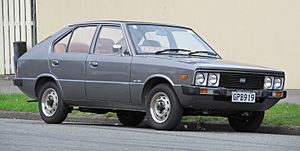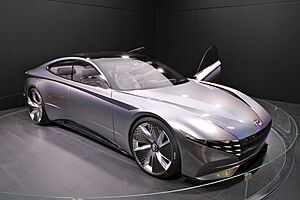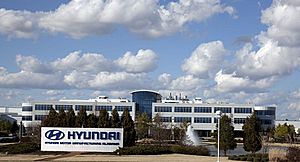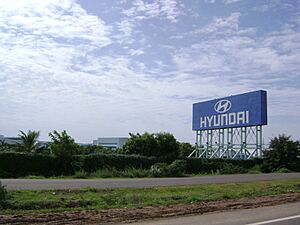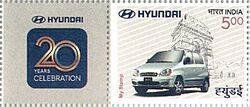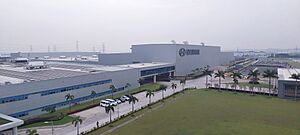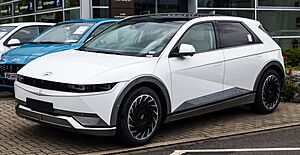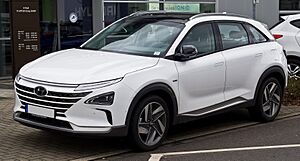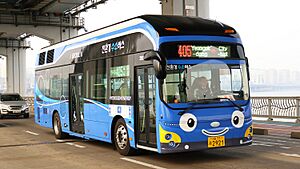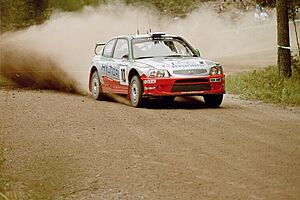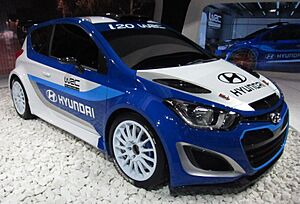Hyundai Motor Company facts for kids

Headquarters (right) in Seoul, South Korea
|
|
|
Native name
|
|
|---|---|
| Hangul |
현대자동차 주식회사
|
| Hanja |
現代自動車株式會社
|
| Revised Romanization | Hyeondae Jadongcha Jusikhoesa |
| McCune–Reischauer | Hyŏndae Chadongch'a Chusikhoesa |
| Public | |
| Traded as | KRX: 005380 LSE: HYUD |
| Industry | Automotive |
| Founded | 29 December 1967 |
| Founder | Chung Ju-yung |
| Headquarters |
,
South Korea
|
|
Area served
|
Worldwide |
|
Key people
|
|
|
Production output
|
|
| Revenue | |
|
Operating income
|
|
| Total assets | |
| Total equity | |
| Owners |
|
|
Number of employees
|
126,407 (2024) |
| Parent | Hyundai Motor Group |
| Divisions |
|
| Subsidiaries |
List
Hyundai Motor India
Hyundai Motors Indonesia Hyundai Motor America Hyundai of Canada Hyundai Motor of South America Hyundai do Brasil Hyundai China Beijing Hyundai Hyundai Japan Hyundai Motor Philippines Hyundai Motor Europe |
Hyundai Motor Company, often called Hyundai Motors or simply Hyundai, is a big car company from South Korea. It started in 1967 and has its main office in Seoul. Hyundai owns a large part of Kia Corporation and also has a luxury car brand called Genesis. Together, these brands form the Hyundai Motor Group.
Hyundai has the world's second-largest car factory in Ulsan, South Korea. This factory can make 1.6 million cars each year. The company employs about 75,000 people around the world. Hyundai cars are sold in 193 countries through 5,000 dealerships. As of late 2024, Hyundai was the world's third-largest carmaker, after Toyota and Volkswagen.
Contents
- Hyundai's Journey: A Look at Its History
- Car Design and Innovation
- Research and Development
- Hyundai's Global Presence
- Hyundai's Product Lineup
- Partnerships
- Motorsport
- Marketing and Community Work
- Hyundai's Leadership Team
- Hyundai's Financial Performance
- See also
Hyundai's Journey: A Look at Its History
How Hyundai Started
Chung Ju-yung started the Hyundai Engineering and Construction Company in 1947. Hyundai Motor Company was created later in 1967. Their first car, the Cortina, was made with Ford Motor Company in 1968.
When Hyundai wanted to design its own car, they hired George Turnbull in 1974. He was a top manager from British Leyland. Turnbull then hired five other skilled British car engineers. In 1975, the Pony was released. It was the first car made in South Korea. Its design came from Giorgio Giugiaro, and its engine technology from Mitsubishi Motors. Hyundai started exporting the Pony to Ecuador and other countries in 1976. By 1982, Hyundai cars were sold in the UK.
In 1984, Hyundai began selling the Pony in Canada. It was very popular there and became a top-selling car. However, it was not sold in the United States because it did not meet emission standards. By 1985, Hyundai had built one million cars.
Growing Around the World
In 1986, Hyundai started selling cars in the United States. The Excel was even named a "Best Product" by Fortune magazine because it was affordable. By 1988, Hyundai began making cars with its own technology, starting with the Sonata. In 1991, the company developed its first own engine, the four-cylinder Alpha, and its own transmission. This helped Hyundai become more independent in technology.
In 1996, Hyundai Motor India Limited was set up with a factory near Chennai, India. In 1998, Hyundai bought most of its rival, Kia Motors. This happened after some financial challenges in the South Korean car industry.
Improving Design and Quality
In 1998, Hyundai decided to improve its image to become a world-class brand. Chung Mong-koo, Chung Ju-yung's son, took over leadership in 1999. The Hyundai Motor Group invested a lot in making their cars better in quality, design, and manufacturing. They also offered a great 10-year or 100,000-mile warranty for cars sold in the United States.
In 2004, Hyundai was ranked high in a quality study by J.D. Power and Associates in North America. Hyundai is now one of the top 100 most valuable brands globally. Since 2002, Hyundai has also been a major sponsor of the FIFA World Cup.
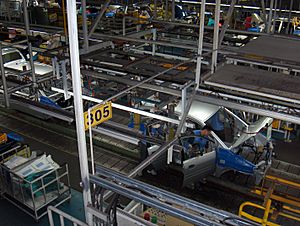
In 2011, Hyundai sold 4.05 million cars worldwide. The Hyundai Motor Group became the world's fourth-largest carmaker. In 2014, Hyundai focused on making its cars handle better. They hired Albert Biermann, a former engineering leader from BMW M, to help with this.
Recent Developments (2020-Present)
On October 14, 2020, Euisun Chung became the new chairman of the Hyundai Motor Group. His father, Chung Mong-koo, became Honorary Chairman. In April 2021, Hyundai's profits grew significantly, reaching their highest in four years.
In June 2021, Hyundai Motor Group bought a large share of the robotics company, Boston Dynamics. Hyundai now owns 80% of the company. In October 2024, Hyundai signed a big agreement to buy renewable energy. This shows their effort to use more clean energy. In November 2024, Jose Munoz, Hyundai's Global Chief Operating Officer, became the first non-Korean to hold the role of global co-CEO. This promotion recognized his success in boosting sales in North America.
Car Design and Innovation
In 2006, Hyundai hired Thomas Bürkle to lead its design center in Germany. He had previously designed cars for BMW. Hyundai's design style was called Fluidic Sculpture, inspired by nature.
In 2018, the company introduced a new design direction called Sensuous Sportiness. This design idea was first shown with the Le Fil Rouge concept car at the 2018 Geneva Motor Show. It has since been used in many new Hyundai cars, from sedans to SUVs. This design strategy won an award in 2020.
Research and Development
Hyundai has six research and development (R&D) centers. Three are in South Korea, and others are in Germany, Japan, and India. There is also a center in California that designs cars for the United States.
Hyundai opened its Hyundai Design Center in Fountain Valley, California in 1990. In 2003, it moved to a new facility in Irvine, California and was renamed the Hyundai Kia Motors Design and Technical Center. This center also houses Hyundai America Technical Center, Inc., which handles all engineering work for Hyundai in the U.S. In 2005, the Hyundai America Technical Center moved to a larger headquarters in Superior Township, Michigan.
In 2004, Hyundai America Technical Center built a proving ground in California City, California. This large facility in the Mojave Desert has a 6.4-mile oval track and other special roads for testing vehicles. It also has offices and indoor testing areas.
In 2020, Hyundai was ranked 4th globally for its industrial design registrations by the WIPO. This shows their strong focus on new designs.
Hyundai's Global Presence
| Rank | Country | Vehicle production (by units) |
|---|---|---|
| 1 | 1,862,403 | |
| 2 | 764,108 | |
| 3 | 361,073 | |
| 4 | 326,660 | |
| 5 | 245,660 | |
| 6 | 214,130 | |
| 7 | 169,765 | |
| 8 | 85,052 | |
| 9 | 56,889 | |
| 10 | 16,490 |
Hyundai has factories in North America, India, the Czech Republic, Russia, China, and Turkey. They also have R&D centers in Europe, Asia, and North America.
North America
United States Operations
Hyundai Motor America started selling cars in the United States on February 20, 1986. Their first model was the Hyundai Excel. In that first year, Hyundai sold more cars than any other new car brand in the U.S., with 168,882 sales.
However, the Excel soon had problems, and Hyundai's reputation for quality suffered. To fix this, Hyundai invested heavily in improving its cars' quality and design. They also offered a 10-year or 100,000-mile warranty, called the Hyundai Advantage.
Hyundai opened a new factory, Hyundai Motor Manufacturing Alabama, in April 2002. This plant in Montgomery, Alabama, was finished in 2004 and cost $1.7 billion. Production started in May 2005.
By 2004, Hyundai's sales had greatly increased, and its reputation improved. In 2004, Hyundai was ranked highly for initial quality in a study by J.D. Power and Associates. In 2009, the Hyundai Genesis luxury sedan was named "North American Car of the Year." The Hyundai Elantra also won this award in January 2012.
Supernal: Flying Taxis
| [[File::None at this time|frameless]] | |
| Industry | Urban air mobility |
|---|---|
| Founded | 2020 |
| Headquarters | |
| Parent | Hyundai Motor Company |
Hyundai Motor Company started Supernal in the United States in 2020. This company focuses on urban air mobility (UAM), which means developing flying taxis. The name "Supernal" means "Best Quality" and "Heavenly." In November 2023, Hyundai announced plans to build a factory in the U.S. to make these flying taxis. As of February 2025, a full-size test model was being tested on the ground.
Supernal's prototype uses special rotors and propellers. Supernal has its main office in Washington, D.C., a research center in Fremont, California, and an engineering office in Irvine, California.
Canada Operations
In 1989, Hyundai Auto Canada Inc. opened a factory in Bromont, Quebec, employing 800 people. This plant was designed to make about 2000 Hyundai Sonatas per week. The plant operated for four years before closing because Hyundai's sales could not support it. Despite this, Hyundai is now the top import car brand in Canada without a local factory.
Mexico Operations
Hyundai Motor Mexico entered the Mexican market in 2014. They sold imported cars like the Grand i10, Elantra, and ix35. Before Hyundai's own brand was introduced, its passenger cars were sold in Mexico under the Dodge brand.
South America
Brazil Operations
In October 2012, Hyundai launched the HB20, a small car designed specifically for Brazil. This car was built at a new Hyundai factory in Piracicaba, São Paulo. This factory was Hyundai's first fully owned plant in Latin America. It can produce 180,000 cars per year.
Hyundai cars have also been made in Brazil by a local partner, Caoa Group, at a factory in Anápolis, Goiás. This production started in 2007 with the HR model.
Asia
China Operations
Since 2002, Hyundai has had a joint company with Beijing Automotive Group to make cars in China. This company, called Beijing Hyundai, also makes models just for the Chinese market. It started by producing the Sonata in December 2002. The joint company sold 700,000 cars in 2010 and 1,120,000 vehicles in 2014. At its busiest, the company had five factories in China.
Hyundai cars sold well in China until 2016, when sales dropped. This was partly because they focused too much on sedans and faced strong competition from local Chinese carmakers.
India Operations
Hyundai Motor India Limited (HMIL) was formed on May 6, 1996. Hyundai's first car in India, the Hyundai Santro, was launched in September 1998 and was very successful. It became the second best-selling car in India by 2000.
Hyundai has two factories in India, located in Sriperumbudur in Tamil Nadu. Together, these plants can make 600,000 cars each year. In 2007, Hyundai opened an R&D center in Hyderabad, which now employs about 450 engineers. Hyundai is currently the second-largest car exporter from India.
Japan Operations
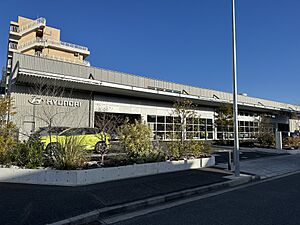
Hyundai started selling its cars in Japan in 2001. Even though Hyundai's sales grew worldwide, they struggled in Japan. They sold only 15,095 passenger cars from 2001 to 2009. In November 2009, Hyundai stopped selling passenger cars in Japan to focus on commercial vehicles.
One reason for their struggle was that Hyundai did not realize how important small cars were in Japan due to parking space issues. On February 9, 2022, Hyundai announced its return to Japan. They started selling eco-friendly vehicles like the Ioniq 5 and Nexo online under the name Hyundai Mobility Japan.
Philippines Operations
Hyundai first entered the Philippine market in the early 1990s with the Hyundai Excel and Hyundai Grace van. Later, they introduced the Hyundai Starex and the second-generation Hyundai Elantra. Hyundai Asia Resources, Inc. (HARI) was the official distributor for Hyundai passenger cars. In early 2022, Hyundai Motor Philippines, Inc. (HMPH) took over as the official distributor for Hyundai passenger cars.
Indonesia Operations
In November 2019, Hyundai announced it was building its first fully owned car factory in Indonesia. This factory, called Hyundai Motor Manufacturing Indonesia (HMMI), is in Cikarang, Bekasi. It started operating in the second half of 2021 and can make 150,000 vehicles each year. Half of these cars are exported to nearby countries in Southeast Asia. Hyundai invested $1.55 billion in this plant and future product development until 2030.
Vietnam Operations
In Vietnam, Hyundai works with Thanh Cong Group to form Hyundai Thanh Cong Vietnam (HTV). In 2023, Hyundai was the best-selling car brand in Vietnam, selling 67,450 vehicles.
Turkey Operations
In September 1997, Hyundai opened a factory in İzmit, Kocaeli Province, Turkey. This facility, called Hyundai Assan Otomotiv, was a joint effort between Hyundai Motor Company and Kibar Holding. It can produce 125,000 cars annually. In May 2013, the factory's capacity increased to 200,000 units.
Malaysia Operations
In November 2024, it was reported that Hyundai Motor would invest RM2.16 billion to build a factory in Kulim, Kedah, Malaysia. This is Hyundai's largest investment in the country so far. The plant is expected to produce 7 models within five years and open in 2025.
Europe
Germany Operations
Hyundai has had an R&D center in Frankfurt, Germany, since 1994. This center monitors new technologies in Europe and designs cars for the European market. In September 2003, the company opened its new European headquarters in Rüsselsheim.
Czech Republic Operations
In November 2008, Hyundai opened its European factory in Nošovice, Czech Republic. This plant cost over 1 billion euros to build. It mainly makes the i30, ix20, and ix35 for the European market. The factory can produce 300,000 cars each year.
Russia Operations
In Russia, Hyundai cars like the Hyundai Accent, Sonata, Elantra, and Santa Fe have been assembled at the TagAZ plant in Taganrog since 2001. In June 2008, Hyundai started building a new factory in Saint Petersburg. This plant began mass production in January 2011, making the Hyundai Solaris and Kia Rio.
In September 2021, Hyundai Wia opened a car engine factory in Saint Petersburg. This was the biggest engine plant in Russia. In January 2024, Hyundai sold its two plants in Russia, leaving the Russian market.
Africa
Southern Africa Operations
In Botswana, Hyundai Accent, Sonata, and Elantra models were assembled by the Motor Company of Botswana from February 1993. Most of these finished cars were exported to South Africa.
Egypt Operations
Hyundai cars are also made in Egypt by the Ghabbour Group in Cairo. They offer a wide range of models, including some sports models unique to the Egyptian market.
Hyundai's Product Lineup
| Rank | Model | Global sales |
|---|---|---|
| 1 | Tucson | 634,297 |
| 2 | Elantra / Avante / i30 Sedan | 368,402 |
| 3 | Creta/Alcazar | 348,740 |
| 4 | Kona/Kauai | 285,233 |
| 5 | Santa Fe | 279,886 |
| 6 | i10/Xcent/Aura | 279,687 |
| 7 | Venue | 192,027 |
| 8 | i20 | 169,013 |
| 9 | Sonata | 167,634 |
| 10 | Palisade | 165,745 |
Hyundai makes many types of vehicles, including sedans, hatchbacks, SUVs, vans, pickups, and large trucks and buses.
Cars
Hyundai's top-selling sedan in 2021 was the Elantra (called Avante in South Korea), with over 380,000 units sold. This model is made in several factories worldwide. Another popular sedan is the Accent/Verna, which is popular in many countries.
Hyundai also makes various hatchback models. The i10 and i20 are built in India and Europe, with some differences for each market. Other hatchbacks include the Santro for India, the i30 for developed markets, and the HB20 for Brazil.
Crossovers and SUVs
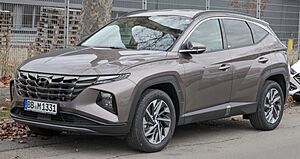
Hyundai entered the crossover SUV market early with the Santa Fe in 2000, followed by the smaller Tucson in 2004. The Santa Fe was very popular in American and European markets. It quickly became Hyundai's best-seller. As of 2020, Hyundai had sold over 5.26 million Santa Fe units globally.
The first Tucson shared its platform with the Kia Sportage. In many countries, the Tucson was replaced by the Hyundai ix35 from 2009 to 2015. However, the Tucson name returned for the third generation in 2015 and is now used worldwide. The Tucson was the fourth best-selling SUV globally in 2020.
By the mid-2010s, Hyundai started making smaller crossover SUVs, like the Creta (ix25 in China) from 2014, and the Kona in 2017. The Kona also comes in hybrid and electric versions. By 2019, these models became very popular. In 2021, Hyundai released the Casper, its smallest car, for the South Korean market.
Currently, Hyundai produces 12 different crossover SUV models for various markets.
Hybrid and Electric Cars
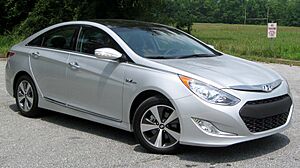
Hyundai Motor Company began developing flexible-fuel vehicles (FFVs) in 1988. They also experimented with hybrid-electric cars in the 1990s. The first pure electric car from Hyundai was the Sonata Electric Vehicle in 1991.
Hyundai started mass-producing hybrid electric vehicles in 2008. They use special lithium polymer batteries. The 2011 Sonata Hybrid began sales in the U.S. in February 2011. In 2009, Hyundai released the Avante LPI Hybrid in South Korea. Hyundai also showed the Hyundai BlueOn, an electric prototype of the i10, in 2009.
By March 2014, Hyundai and Kia had sold a total of 200,000 hybrid cars worldwide.
In 2016, Hyundai introduced the Ioniq, a car designed to compete with the Toyota Prius. The Ioniq is special because it is the first car offered only as a hybrid, plug-in hybrid, or all-electric vehicle. The hybrid version launched in South Korea in February 2016, followed by the electric model in July 2016. The plug-in hybrid came out in February 2017.
In August 2020, Hyundai announced that Ioniq would become its own new electric car brand. They confirmed three new electric cars under this brand. Ioniq is Hyundai's second stand-alone brand after Genesis. The new Ioniq cars use Hyundai's Electric Global Modular Platform (E-GMP). This platform allows for fast charging and long driving ranges. The first model, the Ioniq 5, a midsize crossover, arrived in early 2021. It was followed by the Ioniq 6 sedan in late 2022, and the Ioniq 7, a large SUV, in early 2024.
In December 2020, Hyundai Motor Group shared details about its E-GMP platform. This platform is the base for new Hyundai and Kia electric vehicles starting in 2021. It will also be used for future Genesis electric cars. The platform's main parts include a battery pack under the car and an all-in-one motor, transmission, and inverter designed by Hyundai.
In February 2020, Hyundai launched its first vehicle built on the E-GMP platform, the Ioniq 5. It is the first product under the Ioniq sub-brand. The Ioniq 5 is Hyundai's most advanced electric vehicle. Its battery can charge from 10% to 80% in just 18 minutes using a fast charger. A five-minute charge can add 100 km to its range.
In July 2022, Hyundai announced a new car factory in South Korea. This factory is only for electric vehicles and started production in 2025. It is the first Hyundai plant to open in South Korea since 1996.
Hydrogen Vehicles
In March 2018, Hyundai launched the Nexo, a hydrogen-powered crossover SUV. By October 2020, over 10,000 Nexo vehicles had been sold in South Korea.
In 2020, Hyundai launched a hydrogen-powered version of its Xcient truck, called the Xcient Fuel Cell. They delivered seven of these trucks to customers in Switzerland. The Xcient Fuel Cell is the world's first production hydrogen fuel cell truck. In 2019, Hyundai formed Hyundai Hydrogen Mobility (HHM) with a Swiss company to lease these trucks. Hyundai chose Switzerland because its road tax does not apply to zero-emission trucks.
In 2020, Hyundai also launched a hydrogen-powered version of its Elec City bus, the Elec City FCEV. This bus can carry 44 passengers and has a driving range of 434 km.
Light Commercial Vehicles
Hyundai Motor started making the H350 van (also known as Solati) in Turkey in 2015.
Trucks and Buses
Hyundai's Truck & Bus division makes several heavy trucks and buses. The company began selling trucks in 1969 and its first bus in 1970.
Partnerships
In 2000, Hyundai formed a partnership with DaimlerChrysler. In 2001, the Daimler-Hyundai Truck Corporation was created. However, this partnership ended in 2004 when DaimlerChrysler sold its share in Hyundai Motor.
In February 2021, there were reports that Apple and Hyundai-Kia were close to a deal to build an Apple car that could drive itself. The car was said to be designed by Apple and built in Hyundai or Kia factories. However, Hyundai announced shortly after that they were no longer talking with Apple about this.
Motorsport
For the 2002 season, Hyundai hired famous rally drivers like Juha Kankkunen. In September 2003, Hyundai announced it would leave the WRC due to budget issues. They planned to return later, but it did not happen then.
In 2006, Hyundai considered entering Formula One racing. The Korean Grand Prix was first held in 2010, but Hyundai did not join the championship. Hyundai later focused its rally plans around the Veloster.
Hyundai i20 WRC
The Hyundai i20 WRC is a World Rally Car built by Hyundai for the 2014 World Rally Championship. It is based on the Hyundai i20 car and was first shown at the 2012 Paris Motor Show. This car marked Hyundai's return to the World Rally Championship after ten years. The car is managed by Hyundai's performance division, Hyundai Motorsport, based in Frankfurt, Germany.
Marketing and Community Work
Helping Communities
In 2008, Hyundai Motors created a committee to manage its Corporate Social Responsibility programs. One of these programs is the "Happy Move Global Youth Volunteers Program."
The Hyundai Motors' India Foundation (HMIF) has invested a lot of money in various community programs in India. In 2011, they started the "Go Green" village adoption project in Tamil Nadu. This project aimed to promote eco-friendly products, increase forest cover, and improve living conditions in villages.
In 2020, Hyundai Motors partnered with the UN Development Programme. They launched a campaign called 'for Tomorrow' in 2021 to find solutions for global problems. A documentary film about this project was released in 2022.
Sports Sponsorships
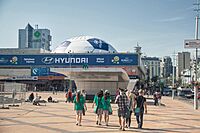
- BCCI
- Jeonbuk Hyundai Motors FC
- FIFA (Since 1999, except the FIFA Club World Cup)
- International Cricket Council
- UEFA (from 2000 to 2017)
- Cricket World Cup (Until 2015)
- Korea Football Association
- A-League
- Inside the NBA
- National Football League
- Sun Bowl
- Hyundai Tournament of Champions
- Olympique Lyonnais (from 2013 to 2020)
- PFC CSKA Moscow
- Millonarios Fútbol Club
- Club Universitario de Deportes
- Tampines Rovers FC
- Al-Fateh SC
- Moroka Swallows F.C.
- Mandurah City FC
- Park United FC
- Carlton Football Club
- Brisbane Lions
- Brisbane Broncos
- AS Cannes Volley-Ball
- Hyundai Hockey Helpers
- Rhys Millen
- Atlético Madrid
- Hertha BSC
- Chelsea FC
- AS Roma
Other Sponsorships
- Academy Awards
- CNN Worldwide
- Hyundai Auto Club Philippines
Hyundai's Leadership Team
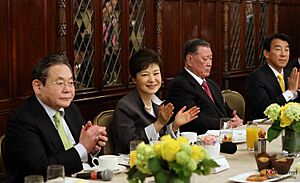
The Board of Directors includes:
- Chung Eui-sun, Executive Chairman of Hyundai Motors
- Chang Jae-hoon, President and CEO of Hyundai Motors
- Lee Dong-seock, Vice President
- Jose Munoz, Global COO
- Gang Hyun-seo, Executive Vice President
- Yoon Chi-won, Former Chairman of EQONEX
- Eugene M. Ohr, Former Partner of Capital International, Inc.
- Sang Seung Yi, Professor of Economics at Seoul National University
- Dal Hoon Shim, Representative of Woorin Tax Partners
- Lee Ji-yun, Professor of Aerospace Engineering at KAIST
- Seung Wa Chang, Professor of Law at Seoul National University
- Yoon Hee Choi, Professor of Law at Konkuk University
Hyundai's Financial Performance
The table below shows Hyundai Motor's financial trends (as of December 31 each year):
| Revenue (US$ bn) |
EBIT (US$ bn) |
Total assets (US$ bn) |
Market cap (US$ bn) |
Employees (k) |
|
|---|---|---|---|---|---|
| 2015 | 80.0 | 7.6 | 141 | 39.4 | |
| 2016 | 81.4 | 6.6 | 148 | 34.4 | |
| 2017 | 86.3 | 4.2 | 167 | 41.1 | |
| 2018 | 88.0 | 2.6 | 162 | 25.7 | 69 |
| 2019 | 90.9 | 3.9 | 168 | 26.4 | 70 |
| 2020 | 89.5 | 2.1 | 193 | 40.2 | 72 |
| 2021 | 101.4 | 7.2 | 197 | 40.3 | 72 |
| 2022 | 109.6 | 8.9 | 203 | 27.7 | |
| 2023 | 123.6 | 14.0 | 218 | 36.9 | 74 |
| 2024 | 127.4 | 13.3 | 232 | 38.5 | 75 |
See also
 In Spanish: Hyundai Motor Company para niños
In Spanish: Hyundai Motor Company para niños
- Bering Truck Corporation
- Hyundai Group
- Hyundai Mobis
- Hyundai Motor Group
- Kia Motors
- List of Hyundai engines
- List of Korean car makers
- List of Hyundai Motor Company transmissions
- List of Hyundai Motor Company manufacturing facilities


